-

人教版新目标初中英语九年级上册I like music that I can dance to教案
教学目标: 1. Express preferences2. Talk about one’s likes and dislikes and the reasons3. Learn to express one’s opinions 4. Learn to write a reply 语言功能: 1) Talk about one’s preferences, using t he relative clause2) Talk about people’s likes and dislikes and the reasons3) Talk about opinions语言结构: Relative clauses with that and who语言目标:What kind of music do you like?I like music that I can sing along with.I love singers who write their own music.We prefer music that has great lyric.重点词汇及短语:heart, photography, interest, class, whatever, miss, okay, expect, sweet, taste, itself, laboratory, cancer, increase, biscuit, main, care, prefer… to…, remind somebody of …, dance to, sing along with, be sure to, interest somebody, make somebody adj., to be honest, suit somebody, on display, catch up教学重难点:What do other people think of the different kinds of things? How to express one’s opinions? 学习方式:讨论,合作学习情感目标:通过本单元的学习,能提高学生的艺术鉴赏能力和审美情趣,并引导学生养成健康的饮食习惯。课时安排5课时第一课时:Section A: 1a-2c第二课时:Section A : 3a-4第三课时:Section B:1-2c, Self check2第四课时:Section B: 3a-4, Self check1第五课时:Self check ReadingI like music that I can dance to.

人教版新目标初中英语九年级上册I used to be afraid of the dark教案
内容提示1.本单元主要内容是学会used to结构。Used to +动词原形表示过去经常、以前常常,只用于过去式中,用来表示现在已不存在的习惯或状态。例如:They used to play football together.他们过去常在一起蹋足球。(现在不在一起踢了)2.used to的疑问形式和否定形式为Did you use to…?和I didn’t use to… 也可以用Used you to…?和I used not to…但现在多使用前者。例如:Did you used to swim in the river? 你过去常在河里游泳吗?I didn’t use to play the piano. 我以前并不经常弹钢琴。教学目标一、学习目标(Language Goal) 1.学会陈述自己过去常做的事情。2.学会陈述自己过去的爱好等。3.能够表达自己现在和过去在外表、性格、娱乐等方面的变化。4.能够表达朋友、家人等现在和过去的变化。二、语言结构(Language Structures) 1.I used to be short when I was young. 我年轻时个子很矮。 2. —Did you use to have straight hair? 你过去是直发吗?—Yes, I did. 是的。 3. —Did you use to play the piano? 你过去弹钢琴吗?—No, I didn’t. 不,我不弹。 4.I used to be afraid of dark. 我过去害怕黑暗。 5.I’m terrified of the snakes. 我害怕蛇。

人教版新目标初中英语九年级上册How do you study for a test教案2篇
内容提示本单元主要内容是学会利用verb十by/with gerund表示方式方法来讨论学习英语的策略,认识自己在学习方面的长处和不足。初步了解现在完成时的结构和用法。现在完成时由助动词have/has+动词的过去分词构成,主要表示过去发生的某一动作对现在仍有影响或造成的后果,常与already,yet,just,ever,never等副词连用。教学目标一、学习目标(Language Goal) 1. Talk about how to study . 学会讨论各种学习方法和策略。2. Find out your suitable learning methods. 找出适合自己的学习方法。 二、语言结构(Language Structures) 1. Verb + by with gerund by+动名词短语 表示“通过…途径,方法” 2. How questions have引导的特殊疑问句 三、目标语言(Target Language) 1. How do you study for tests ? 你是怎样准备考试的?Well , I study by working with my classmates. 哦,我和同学们一起学习。2. Have you ever studied with a group ? 你曾经参加过学习小组吗?Yes , I have . I’ve learned a lot that way . 是的,参加过。通过这种方式我学了许多。

人教版新目标初中英语九年级下册By the time I got outside, the bus had already left教案
Ⅰ. Teaching Aims and Demands1. Knowledge Objects(1) Key Vocabularyoversleep(2) Target LanguageWhat happened?I overslept. And by the time I got up, my brother had already gotten in the shower.2. Ability Objects(1) Teach the students to use the new words.(2) Train the students to narrate past events with the Past Perfect Tense.(3) Train the students' listening and speaking skills with the target language.3. Moral ObjectIt’s a good habit to go to bed early in the evening and get up early in the morning. So you’ll never be in a hurry in the morning.Ⅱ. Teaching Key Points1. Key Vocabularyoversleep2. Target LanguageNarrate past events with the Past Perfect TenseⅢ. Teaching Difficult Points1. Train the students to narrate past events with the Past Perfect Tense.2. Train the students to understand the target language in spoken conversation.Ⅳ. Teaching Methods1. Thinking of examples from the students' real lives.2. Making sentences by looking at the pictures.Ⅴ. Teaching AidA tape recorderⅥ. Teaching ProceduresStep I Revision1. Revise the language points in Unit 8.Ask some questions like this: What volunteer work would you like to do?Help the students to answer, I’d like to…/I love to…/I hope to2. Practice the dialogue in Activity 3c on page 62 again. Get students to role play the similar dialogues with the following.

人教版新目标初中英语九年级上册It must belong to Carla教案
一、Section A该部分有4个模块。第一模块围绕Whose volleyball is this? 这一话题展开思维( 1a)、听力(1b)、口语( 1c)训练;第二模块围绕上一模块中的话题进行听力( 2a-2b)、口语训练( 2c);第三模块继续围绕前两个模块中的“making inferences”展开训练。训练形式为阅读排序( 3a)和两人问答(3b);第四模块仍就上一话题展开讨论。二、Section B该部分有4个模块。第一模块要求根据图画和所提供的单词写出合理的句子;第二模块在听力( 2a-2b)和分角色口语训练( 2c)的基础上,继续进行“推测”训练; 第三模块围绕“Strange events in Bell Tower neighborhood”这一话题展开阅读( 3a)和写作(3b -3c)训练;第四模块以dream为话题展开小组活动。三、Self Check该部分有3个模块。第一模块以填空形式对所学词汇进行训练;第二模块就8个谚语展开阅读和讨论。

人教版新目标初中英语九年级上册Where would you like to visit教案2篇
The First PeriodⅠ.Teaching Aims and DemandsKnowledge Objects(1) Key Vocabularytiring, educational, fascinating, thrilling, peaceful, exotic, trek, jungle, take it easy, explore, historic, site(2) Target LanguageWhere would you like to go on vacation?I’d like to trek through the jungle, because I like exciting vacations.2. Ability Objects(1)Train students to talk about places they would like to visit with the target language.(2)Train students to describe vacations with different adjectives.(3)Train students' listening skill.3. Moral Object,It′s more interesting to go on vacating somewhere instead of staying at home.Ⅱ. Teaching Key Points1. Key Vocabularytiring, educational, fascinating, thrilling, peaceful, exotic, trek, jungle, take it easy, explore, historic, site2. Target LanguageTalk about different places with the target language.Ⅲ. Teaching Difficult Points1. Describe vacations with different adjectives.2. Talk about different places with the target language.Ⅳ. Teaching Methods1. Teaching by illumination2. Teaching by doing chain drills3. Teaching by pairworkⅤ. Teaching Aids1. A tape recorder2. Some pictures of different places with famous views

人教版新目标初中英语九年级下册Rainy days make me sad教案
1. 教材分析本单元以how do things affect you?为话题, 从颜色、天气、音乐、广告、产品等方面谈论了外界事物如何影响人的心情。要求学生掌握表达某物或某事给人带来的感觉、看法或影响等。共设计了四个部分的内容:Section A 该部分有4个模块:第一模块围绕Which restaurant would you like to go to?这一话题展开思维(1a)、听力(1b)、口语(1c)训练;第二模块围绕How does music affect you? 进行听力(2a-2b)、口语训练(2c);第三模块继续围绕how do colors in the restaurant affect you这一话题展开训练,训练形式为阅读和问题体验(3a)和小组活动(3b);第四模块仍就How do things affect you这一话题以调查的形式展开讨论。Section B该部分有4个模块:第一模块围绕产品广告对人们的影响这一话题以“配对”(1a)与“列举”(1b)两种形式展开训练;第二模块继续围绕How do things affect you? 进行听力(2a-2b)、口语对话训练(2c);第三模块围绕“Advertising”这一话题展开阅读(3a-3b)和写作(3c)训练;第四模块围绕How posters affect you这一话题以口语训练形式展开小组活动。

人教版新目标初中英语九年级下册Could you please tell me where the restrooms are教案
Step Ⅰ RevisionCheck homework. Ask a few students to read the article in 3a.Then ask a few students to read their guides.Step Ⅱ Part 1Look at the words in the box. Ask a student to read them. Make sure the students understand the meaning of the words. You are to fill in the blanks with the words. In some cases, students may need to use another form of the word, for example adjusting for tense or subject/ verb agreement.Ask students to fill in the blanks on their own.Check the answers. Step ⅢPart 2Go through the instructions with the class.Look at the example with the students.Ask students what the answer would be.Ask a student to read the question and answer it.Excuse me, could you tell me where the bank is, please?The bank is across the street from the shopping malt.Get students to complete the work in pairs.Check the answers. Ask a few students to read their questions.Step Ⅳ Just for Fun!Ask all the students to read the conversation. Ask: What is funny about this cartoon? Help students to explain. A Martian is a person from the planet Mars.There is no such thing as Martian food on Earth, and the clerk looks silly because he is trying to think of where there is a Martian restaurant.Invite some pairs of students to present this conversation to the rest of the class.Step Ⅴ Summary and HomeworkIn this class, we’ve done much writing practice using the key vocabulary words and the target language presented in this unit. After class, please finish the questions in 2 in your exercise books. Then finish the exercises on pages 47~48 of the workbook as well.The Seventh Period Ⅰ Teaching Aims and Demands1. Knowledge Objects(1) Key Vocabularyimage, adventure, jealousy, hero, crime, journey, brave, no longer, show interest in, take it easy, become interested in, plain looks(2)Text:Grown-ups like cartoons, too.2. Ability Objects(1) Fast-reading to get a general idea of the text.(2) Careful-reading to get the detailed information in the text.

人教版新目标初中英语九年级下册I’ll help clean up the city parks教案
Talk about offering help (P60)I’ll help clean up the city parks.A: I’d like to work ...B: You could help ...Talk about ways to tell people about the Clean-Up Day (P61)We need to ...We can’t ...I’ll ...Talk about the work the volunteers do (P62)These three students all volunteer their time to help other people.Somebody loves to ... / helps ... / plans to ... / wants to ...A: What do you like doing?B: I like ... A: What kind of volunteer work do you think I could do?B: You could ...1. 重点词汇advertisement, fix, repair, pleasure, blind, deaf, shut, carry, specially, fetch2. 认读词汇hunger, homeless, cheer, clean-up, sign, establish, major, commitment, elementary, veterinarian, coach, similar, call-in, strategy, disabled, organization, unable, support, appreciate, donation, part of speech, pronoun, adverb, preposition, conjunction, donate, Jimmy, Sally3. 词组clean up, cheer up, give out, put off, set up, think up, take after, fix up, give away, put up, hand out, work out, at once

人教版新目标初中英语九年级下册We’re trying to save the manatees教案2篇
本单元主要围绕着有关濒临灭绝的动物这一话题,学习了应该怎样保护我们的环境,以及就某一问题展开辩论。目标提示语言目标能够运用所学知识,就某一问题展开辩论。认知目标1、复习一些语法:现在进行时、一般现在时、用used to 表示一般过去时、现在完成时、一般过去时的被动语态。2、学会表达同意和不同意。3、学会以下基本句型:We’re trying to save the manatees.Manatees eat about 100 pounds of food a day.There used to be a lot of manatees.In 1972,it was discovered that they were endangered.Some of the swamps have become polluted.情感目标了解一些濒临灭绝的动物的生活习性和濒临灭绝的原因,教育学生应该如何保护环境。教学提示充分利用多媒体等教学设备,创设与本课话题相关的情境,如各种不同种类的动物、动物园以及有关环境的画画等等。围绕着本单元的教学目标,设计一些贴近学生实际的教学任务,如让学生谈论自己最喜欢的动物,如何拯救濒危动物,如何保护环境等等。让学生根据所学知识,就动物园是否对动物有利以及其他的话题进行辩论。

人教版新目标初中英语九年级下册You’re supposed to shake hands教案
教学目标:1. 掌握本单元一些重点词汇的写法和用法。2. 学会自如谈论餐桌礼仪。Step 1 RevisionAsk some students to retell the customs at the table in France in the passage in 3a.Step 2 Self checkPart 1. Fill in each bland with the correct word given. Students do the exercises by themselves at first. Then check the answers. Ask the students to comprehend the sentences and help them point out uses of some words, like “arrive (at / in) sw., spend time / money on sth , spend time / money (in) doing sth.”Part 2. Read about Fan Ling’s experience in a western restaurant. Understand the passage. Point out some key points in the passage.1. be / get used to doing sth. 习惯做某事2. begin with = start with 以….开头3. crowd v. 挤满,塞满 the crowd 人群 crowded adj. 拥挤的Then students discuss about how she would solve her problem. Ask some to share their stories with others.Part 3. Complete the crossword by looking at the sentences on the left. Then check the answers.
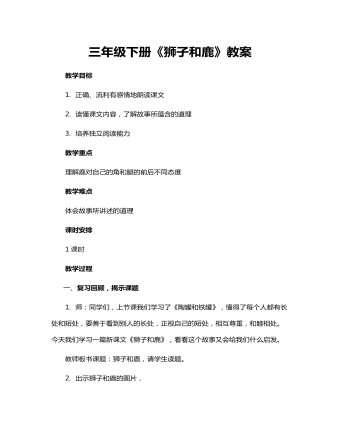
人教版三年级下册《狮子和鹿》教案
教学目标1. 正确、流利有感情地朗读课文2. 读懂课文内容,了解故事所蕴含的道理3. 培养独立阅读能力教学重点理解鹿对自己的角和腿的前后不同态度教学难点体会故事所讲述的道理课时安排1课时教学过程一、复习回顾,揭示课题1. 师:同学们,上节课我们学习了《陶罐和铁罐》,懂得了每个人都有长处和短处,要善于看到别人的长处,正视自己的短处,相互尊重,和睦相处。今天我们学习一篇新课文《狮子和鹿》,看看这个故事又会给我们什么启发。教师板书课题:狮子和鹿,请学生读题。2. 出示狮子和鹿的图片,师:看到这两种动物,联想到了什么呢?学生回答。师:狮子凶猛,鹿很美丽,这个大家都已知道。不过,这篇课文通过狮子和鹿的故事却要告诉我们一个新的道理,是什么呢?下面就看谁的读书本领强,能够自己读懂课文,领悟这个道理了。
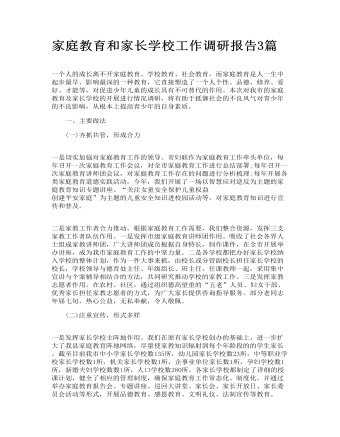
家庭教育和家长学校工作调研报告3篇
一是切实加强对家庭教育工作的领导。市妇联作为家庭教育工作牵头单位,每年召开一次家庭教育工作会议,对全市家庭教育工作进行总结部署;每年召开一次家庭教育讲师团会议,对家庭教育工作存在的问题进行分析梳理;每年开展各类家庭教育道德实践活动,今年,我们开展了一场以智慧应对逆反为主题的家庭教育知识专题讲座、“关注女童安全保护儿童权益创建平安家庭”为主题的儿童安全知识进校园活动等,对家庭教育知识进行宣传和普及。
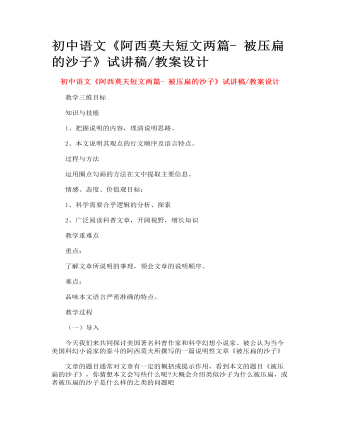
初中语文《阿西莫夫短文两篇- 被压扁的沙子》试讲稿_教案设计
质疑问难,合作探究 1、文章是介绍沙子的知识吗? 明确: 有关恐龙灭绝的原因,原来本文的主角不是沙子,而是恐龙。 2、题目是《被压扁的沙子》,内容却恐龙灭绝的原因,题目《被压扁的沙子》是否偏离主题了?我们换成《恐龙是怎样灭绝的》会不会更好? 本文题目不但没有离题,还能提示读者,恐龙灭绝的“撞击说”所以产生,与被压扁的沙子的科学发现和科学研究密不可分此外,文题形象性强,容易激起好奇心,引起人们的阅读兴趣 3、恐龙灭绝的原因一直是学术界有争议的问题,因而产生两种学说“撞击说”“火山说”在探究恐龙灭绝的原因时,作者的观点是什么?他的观点以什么为依据,又是怎样推论出来的?
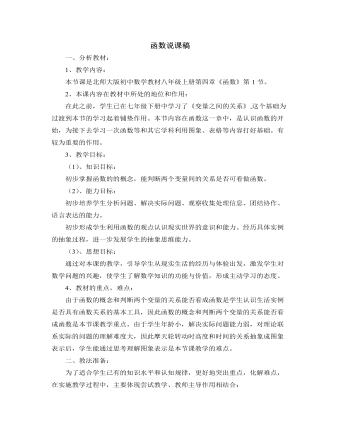
北师大版初中八年级数学上册函数说课稿
然后能通过图象找出变量的对应关系在图象上的体现。3、做一做:课本P154第1小题,学生在课本上填表,让学生通过填表,体会变量之间的相依关系。4、师生小结:和学生一起对刚才的三个例子进行总结,启发学生思考三个例子的相同点和不同点,如表现形式不同,有图象、表格、代数表达式。相同的有它们都是两个变量,确定其中一个变量后就能相应确定另一个变量的值。从而使学生的认识上升一个高度,并掌握函数的概念5、课堂练习:完成课本P155随堂练习。通过本练习的完成巩固概念并会用概念去判断两个变量间的关系是否可看做函数。6、新课巩固:以填空形式对本堂课进行小结,使学生对函数的概念及应用有一定记忆。并通过对最后问题的思考使学生意识到数学来自生活,并能应用于生活。
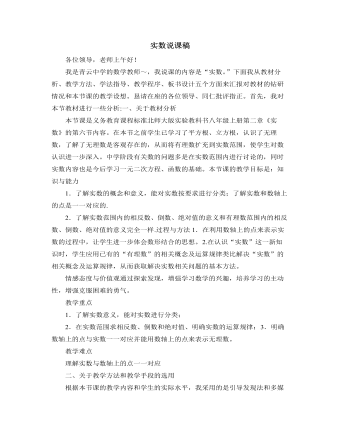
北师大版初中八年级数学上册实数说课稿
接下来学生类比有理数中相关概念,体会到了实数范围内的相反数、倒数、绝对值的意义,并进一步掌握了实数的相反数、倒数、绝对值等知识。学生类比有理数中相关运算,体会到了实数范围内的运算及运算律。并探讨用数轴上的点来表示实数,将数和图形联系在一起,让学生进一步领会数形结合的思想,利用数轴也可以直观地比较两个实数的大小。然后通过相关练习,检测学生对实数相关知识的掌握情况。最后学生交流,互相补充,完成本节知识的梳理。布置作业:所布置作业都是紧紧围绕着“实数”的概念及运用。设计选作题是为了给学有余力的学生留出自由发展的空间。五、关于板书设计我将板书设计为“提纲式”。这样设计主要是力求重点突出,能加深学生对重点知识的理解和掌握,便于记忆。

部编人教版六年级下册《难忘小学生活》说课稿
一、说教学目标1.回忆值得细细回味的点点滴滴,回忆印象最深的人或事。 2.和同学分享令人难忘的集体活动,舍不得的人,有特殊意义的物品,或者一两个关于成长的故事。3.以学生为主体,通过阅读、交流、活动等方法引导学生。 4.回忆小学生活的美好时光,在写一写中感受生活的美好,激发学生对母校、对老师的热爱和感激之情。 5.感受生活的美好,激发师生情、同学情及学生对母校的感激之情。二、说教学重难点1.引导学生围绕“难忘”表达出自己的真情实感。(重点)2.培养学生的合作精神和组织、策划能力。(难点)三、说教法学法1.情境导入法由一首学生耳熟能详的小诗,把他们引入一个故事的情境,既为课文学习、了解田老师的教学方法打下基础,又创设了一个轻松、惬意的教学情境,对于刚从暑假回到课堂的学生来说,这一点非常重要。
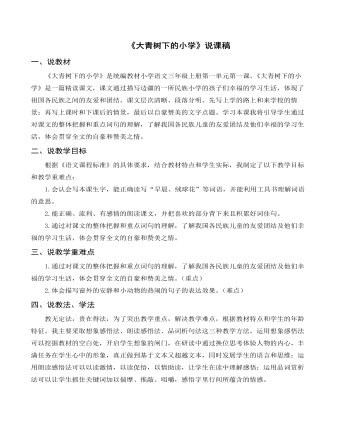
部编人教版三年级上册《大青树下的小学》说课稿
三、说教学重难点1.通过对课文的整体把握和重点词句的理解,了解我国各民族儿童的友爱团结及他们幸福的学习生活,体会贯穿全文的自豪和赞美之情。(重点)2.体会描写窗外的安静和小动物的热闹的句子的表达效果。(难点)四、说教法、学法教无定法,贵在得法,为了突出教学重点,解决教学难点,根据教材特点和学生的年龄特征。我主要采取想象感悟法、朗读感悟法、品词析句法这三种教学方法。运用想象感悟法可以挖掘教材的空白处,开启学生想象的闸门,在研读中通过换位思考体验人物的内心,丰满任务在学生心中的形象,真正做到基于文本又超越文本,同时发展学生的语言和思维;运用朗读感悟法可以以读激情,以读促悟,以情助读,让学生在读中理解感悟;运用品词赏析法可以让学生抓住关键词加以揣摩、推敲、咀嚼,感悟字里行间所蕴含的情感。
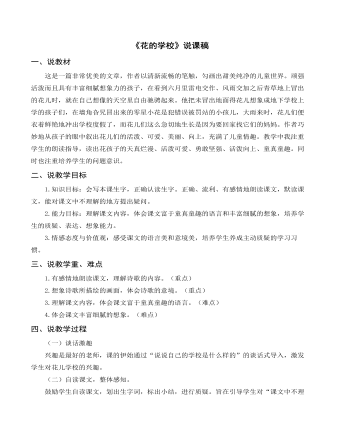
部编人教版三年级上册《花的学校》说课稿
一、说教材这是一篇非常优美的文章,作者以清新流畅的笔触,勾画出甜美纯净的儿童世界。顽强活泼而且具有丰富细腻想象力的孩子,在看到六月里雷电交作、风雨交加之后青草地上冒出的花儿时,就在自己想像的天空里自由驰骋起来。他把未冒出地面得花儿想象成地下学校上学的孩子们,在墙角旮旯冒出来的零星小花是犯错误被罚站的小孩儿,大雨来时,花儿们便衣着鲜艳地冲出学校度假了,而花儿们这么急切地生长是因为要回家找它们的妈妈。作者巧妙地从孩子的眼中叙出花儿们的活泼、可爱、美丽、向上,充满了儿童情趣。教学中我注重学生的朗读指导,读出花孩子的天真烂漫、活泼可爱、勇敢坚强、活泼向上、童真童趣。同时也注重培养学生的问题意识。二、说教学目标1.知识目标:会写本课生字,正确认读生字。正确、流利、有感情地朗读课文,默读课文,能对课文中不理解的地方提出疑问。 2.能力目标:理解课文内容,体会课文富于童真童趣的语言和丰富细腻的想象,培养学生的质疑、表达、想象能力。 3.情感态度与价值观:感受课文的语言美和意境美,培养学生养成主动质疑的学习习惯。
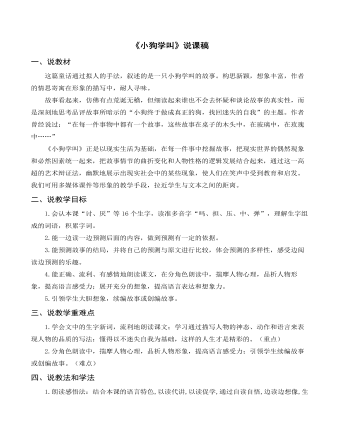
部编人教版三年级上册《小狗学叫》说课稿
一、说教材这篇童话通过拟人的手法,叙述的是一只小狗学叫的故事。构思新颖,想象丰富,作者的情思寄寓在形象的描写中,耐人寻味。 故事看起来,仿佛有点荒诞无稽,但细读起来谁也不会去怀疑和谈论故事的真实性,而是深刻地思考品评故事所暗示的“小狗终于做成真正的狗,找回迷失的自我”的主题。作者曾经说过:“在每一件事物中都有一个故事,这些故事在桌子的木头中,在玻璃中,在玫瑰中……” 《小狗学叫》正是以现实生活为基础,在每一件事中挖掘故事,把现实世界的偶然现象和必然因素统一起来,把故事情节的曲折变化和人物性格的逻辑发展结合起来,通过这一高超的艺术辩证法,幽默地展示出现实社会中的某些现象,使人们在笑声中受到教育和启发。我们可用多媒体课件等形象的教学手段,拉近学生与文本之间的距离。